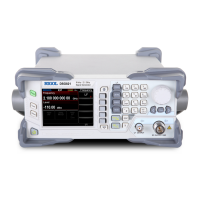Chapter 1 Overview RIGOL
DSG800 Performance Verification Guide
Chapter 1 Overview
Test Preparations
Before performing the test, make the following preparations.
1. The RF signal generator is stored for at least two hours under a temperature of 0℃ to 50℃
and is warmed up for 40 minutes.
2. Make sure that the instrument is within the calibration period (1 year).
3. The test devices required should fulfill the requirements of the "Specification" column in Table
1-1. You can also use the recommended models in the following table for the test.
Table 1-1 Test Devices Required
Device Specification Qty. Recommended
Signal Analyzer
[1]
Total amplitude uncertainty: ±0.19 dB
Option: analog modulation and demodulation, phase noise
test
1 Agilent N9030A
Spectrum Analyzer
(Optional)
Total amplitude uncertainty: ±0.24 dB 1 Agilent E4440A
Signal Analyzer
(Optional)
Frequency range: 9 kHz to 7.5 GHz
Option: analog modulation and demodulation
1 Agilent N9000A
Power Meter and
Power Sensor
Resolution: 0.001 dB
Reference accuracy: ±1.2%
Frequency range: 9 kHz to 18 GHz
Max. SWR:
1.13 (9 kHz to 2 GHz)
1.19 (2 GHz to 14 GHz)
1.22 (14 GHz to 16 GHz)
1.26 (16 GHz to 18 GHz)
Amplitude range: 1 nW to 100 mW (-60 dBm to +20 dBm)
1
Agilent N1913A
and Agilent
E9304A
Function/Arbitrary
Waveform Generator
Max. output frequency: > 1 MHz
Flatness (< 1 MHz): ±0.3 dB
Amplitude accuracy (the amplitude is 2 Vpp): < ±30 mV
1
RIGOL DG4162 or
DG4062
Dual-N Cable
N (male)-N (male) cable
Frequency range: DC to 6 GHz
SWR: < 1.1
Insertion loss: < 1 dB
1
--
Dual-BNC Cable BNC (male)-BNC (male) cable 2
--
N-BNC Cable N (male)-BNC (male) cable 1
--
Note: [1] This signal analyzer can be used in place of the Agilent E4440A spectrum analyzer plus the N9000A
signal analyzer.

